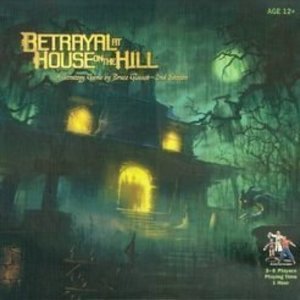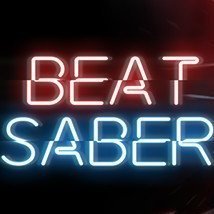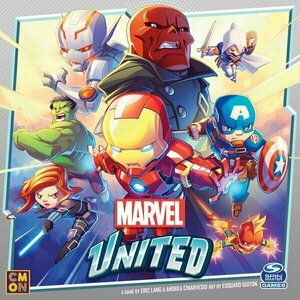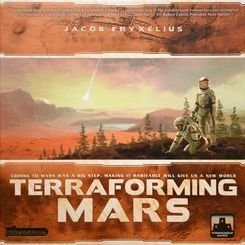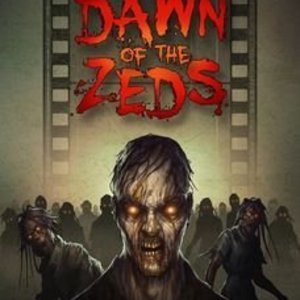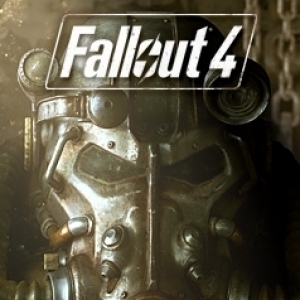Search
Dillon Jacoby-Rankin (202 KP) rated Betrayal at House on the Hill in Tabletop Games
Jan 18, 2020
Great Components (3 more)
Expandable
Plays a decent group size
Replayability
If you punch out all the monster tokens the first time you play, it's hard to find the ones you need later in future games. (1 more)
Play Time can be long depending on the haunt you get.
You never know what to quite expect
Players: 3-6 This is a great group size. I always welcome games that support 5-6 because we always seem to have that 1 extra player we were not expecting to show up.
Expansions: This game already has one expansion called Widows Walk. It adds a roof floor to the game as well as new cards of all three types, and as you may imagine a whole new set of haunts to play.
Replayability: The game has 50 haunts or so in the base game and with widows Walk it adds a bunch more. The game can be played over and over and based on the tiles in the house and the haunt that is played, your experience is almost never going to be the same twice.
Components: The cards are all really nice as well as the tiles for the rooms. The trackers for the characters could be better but they actually already made an upgrade pack for that so problem solved. My only gripe is that the doorways are all highlighted in a specific color but the windows are not. There are several rules that require you to be in a room with a window but they are not highlighted like the rooms with doorways. This could have easily been fixed before launching the game. Also, the symbols for the cards are hard to read on the yellow artworked rooms. In blends right in the background on them and I always have to point out that there is in fact a symbol for a card on those rooms.
Expansions: This game already has one expansion called Widows Walk. It adds a roof floor to the game as well as new cards of all three types, and as you may imagine a whole new set of haunts to play.
Replayability: The game has 50 haunts or so in the base game and with widows Walk it adds a bunch more. The game can be played over and over and based on the tiles in the house and the haunt that is played, your experience is almost never going to be the same twice.
Components: The cards are all really nice as well as the tiles for the rooms. The trackers for the characters could be better but they actually already made an upgrade pack for that so problem solved. My only gripe is that the doorways are all highlighted in a specific color but the windows are not. There are several rules that require you to be in a room with a window but they are not highlighted like the rooms with doorways. This could have easily been fixed before launching the game. Also, the symbols for the cards are hard to read on the yellow artworked rooms. In blends right in the background on them and I always have to point out that there is in fact a symbol for a card on those rooms.

CRC Handbook of Chemistry and Physics
Book
Proudly serving the scientific community for over a century, this 97th edition of the CRC Handbook...
Jesters_folly (230 KP) rated the PC version of Beat Saber in Video Games
Sep 14, 2019
Beat Saber is a rhythm/dance game for PC VR. The premise is quite simple, you are armed with two Sabers, one red & one blue (Although some levels have different colours) and you have to hit blocks of the corresponding colour in time to music. Sounds easy right but, the blocks have arrows on them to tell you which direction you have to hit them in, you also have to avoid hitting bombs and avoiding walls. Being a VR game the blocks come towards you and you are free to swing the Sabers in any direction (Just make sure you’re not going to hit anything/one in reality.) and, to avoid the walls you do actually need to move and duck to get out of the way.
There is a good selection of songs available with (at the time of writing) three albums and one ‘extras’ track list for free and two albums to buy as expansion packs. One of the expansions is a pack by Imagine Dragons so I hold hopes that more bands will release official content. If you don’t like the tracks provided then you have two options; the game has an inbuilt level editor so you can make your own game maps or, if you don’t feel creative then beat Saber does support modding, although not through Steam and there are a large number of songs available this way, not to mention different Sabers, effects and other little treats.
Each song has anything from one to five levels of difficulty and some of the mods do seem harder than the level advertised.
The one thing a lot of people say is missing it multi player. There is a mode where one player has a turn then passes the headset to the nest player and you compare scores but you can’t currently play directly against someone else although I believe this function is being worked on.
There is a good selection of songs available with (at the time of writing) three albums and one ‘extras’ track list for free and two albums to buy as expansion packs. One of the expansions is a pack by Imagine Dragons so I hold hopes that more bands will release official content. If you don’t like the tracks provided then you have two options; the game has an inbuilt level editor so you can make your own game maps or, if you don’t feel creative then beat Saber does support modding, although not through Steam and there are a large number of songs available this way, not to mention different Sabers, effects and other little treats.
Each song has anything from one to five levels of difficulty and some of the mods do seem harder than the level advertised.
The one thing a lot of people say is missing it multi player. There is a mode where one player has a turn then passes the headset to the nest player and you compare scores but you can’t currently play directly against someone else although I believe this function is being worked on.
Purple Phoenix Games (2266 KP) rated Marvel United in Tabletop Games
Sep 1, 2021
This has probably been mentioned before, but I love Marvel superheroes. My favorite has got to be Spider-Man, hands down. Feel free to send me an email if you’d like to hear my thoughts on who is the best Spider-Man – Tobey Maguire, Andrew Garfield, or Tom Holland. I’m getting off topic here… Anyway – when I saw the massive Kickstarter campaign for Marvel United, I knew it was going to be big. Admittedly, I didn’t join in on the campaign (teacher salaries, amiright?), but I did snag a copy of the base game post-campaign. Does the game live up to my expectations? Or does it fall flat, like a DC movie? (OOOOOOH BURN)
Disclaimer: This review encompasses only the base game of Marvel United. There are a number of expansions, but they will not be addressed in this review. -L
Marvel United is a cooperative game in which players take on the roles of various Marvel superheroes tasked with stopping the main Villain from completing their Villainous Plot. Follow the setup instructions detailed in the rulebook, selecting a Villain with whom to battle, 6 random Locations, and whichever Heroes you decide to use to fight the big bad. Place Threat cards, Civilians, and Thugs on the various Locations as indicated, and place the Villain and Heroes as described in the rules. Shuffle the Master Plan deck and respective Hero decks, and each player draws a hand of 3 cards. Choose a Hero as the ‘starting’ Hero, and the game is now ready to begin!
Over a series of turns, players will be resolving Villain effects and playing Hero cards to perform actions. The game always begins with a Villain turn, and the first step is to reveal a Master Plan card, adding it to the Storyline (table). Master Plan cards have different effects to be resolved – move the Villain to a new Location, BAM! effects (usually attacking Heroes or advancing their Villainous Plot towards victory), and adding Civilians/Thugs to surrounding Locations. Once all effects on the Master Plan card are dealt with, the game moves to a Hero turn. During a Hero turn, the player will perform 4 steps: Draw a card, Play a Card, Resolve Actions, and Location Effects. To start, the player will draw a card from their Hero deck and add it to their hand. They then select a card from their hand to play, adding it to the end of the Storyline.
Looking at the symbols at the bottom of their played card, the Hero will now resolve their actions. Actions could be Movement (to an adjacent Location), Attack (Thugs/Henchmen or the Villain in their current Location), Heroic Actions (rescuing Civilians or working to clear the Threat on their current Location), or Wild (any of the previous actions). During this step, a cool twist comes into play – after all, the game is called Marvel United, right? When a Hero plays a card, they resolve the symbols on the bottom of their card AND the symbols on the bottom of the previously played Hero card! This simulates the various Heroes uniting their efforts to take down the Villain! So when selecting your card, be sure to check out the last card to see if you can create a sweet chain of actions for maximum benefit. The final step is to use Location effects, if applicable. Location effects are only available after the Threat to the Location has been cleared, and allows the player to perform special actions (draw extra cards, move to other Locations, etc.). If you end your turn on a Location that has been cleared, you may use its ability if you so choose.
In order to defeat the Villain, the Heroes must complete Missions. The 3 Missions in each game are to Rescue Civilians, Defeat Thugs, and Clear Threats. So with their actions on their turns, Heroes will be working to complete these Missions, moving them closer to victory. The turn sequence of the game is unique as well – the Villain will take a turn after every 3rd Hero turn, not opposite every single Hero. Keep that in mind as you decide which card to play when! The game essentially continues in this fashion (with a few extra effects) until either the Heroes win or they lose. Heroes win if they defeat the Villain! The Villain is defeated when at least 2 Missions are completed, and the Villain has been sufficiently damaged by Attacks. Heroes lose if the Villain completes their Villainous Plot, the deck of Master Plan cards has run out, or if any Hero starts their turn with no cards left to play. The Heroes either win together or lose together.
So I know that kind of sounds like a lot, but I promise that once you get playing, the game flows really well and is pretty intuitive. Marvel United can basically be broken down into 2 steps: Villain turn and Hero turn. All you are doing is playing cards and resolving actions to complete your goals. One of the coolest things about this gameplay is the fact that on your turn you resolve not only your played card, but also the previously played Hero card as well. It does a good job emulating the Heroes working together, and adds a strategic element to the overall gameplay. Maybe you wanted to play a certain card, but based on the last Hero card, you should play this one to benefit the group the most. Players really are all working together to defeat the Villain, instead of each playing their own Hero and going in for the fight one-on-one.
Another neat aspect of the game is the inclusion of the Missions. Heroes are not allowed to directly attack the Villain until at least 2 Missions have been completed. This ups the gameplay because it stops players from just going straight for the Villain from the start, not taking anything else into account. In ‘real life,’ Heroes are also concerned with saving Civilians and neutralizing threats, so the Mission requirement makes the gameplay feel more authentic. Well, as authentic as a superhero game can feel…. The variability of Locations and the random setup of Threats each game means that you likely won’t play the same game twice. Add in expansions too and you’ve got even more scenarios. With different Hero choices, you get to try out different combinations and find out which Heroes really work well together. The gameplay itself may be simple (draw cards, play cards, resolve cards) but the variety of Heroes, Villains, Locations, Threats, etc. keeps it engaging and entertaining.
As for components, I only have positive things to say. The Villain/Hero minis are chunky and cute, the artwork is all colorful and fun to look at, and the cardboard tokens are thick and crisp. All the symbolism in the game is clear, and the text is legible and easy to comprehend. One thing to consider is that this game can be a bit of a table hog if you let it. So just be prepared for a bit of a bigger footprint with this one. Overall, great production quality of the base game, and from what I’ve seen of the expansions, those are top notch as well.
Don’t let the cutesy artwork fool you – Marvel United isn’t an easy game by any means. It takes a decent amount of strategy to be successful, and it does really take a team effort. You stay engaged in the gameplay right up until the very end, and it’s more involved than you would think for being a lighter game. I am also a big fan of Marvel Legendary, and I have to say that this gives me those vibes, but in a more simplified and streamlined way. I’m not sure I would go as far as to call Marvel United “Marvel Legendary Jr.,” but it’s also not entirely a bad idea….. Overall though, I really liked Marvel United way more than I first anticipated. It’s light, yet strategic, and has some unique elements that keep you on your toes. I can’t wait to get my hands on some of the expansions to see how I can mix and match and create even more awesome scenarios! Purple Phoenix Games gives this one a heroic 16 / 18.
Disclaimer: This review encompasses only the base game of Marvel United. There are a number of expansions, but they will not be addressed in this review. -L
Marvel United is a cooperative game in which players take on the roles of various Marvel superheroes tasked with stopping the main Villain from completing their Villainous Plot. Follow the setup instructions detailed in the rulebook, selecting a Villain with whom to battle, 6 random Locations, and whichever Heroes you decide to use to fight the big bad. Place Threat cards, Civilians, and Thugs on the various Locations as indicated, and place the Villain and Heroes as described in the rules. Shuffle the Master Plan deck and respective Hero decks, and each player draws a hand of 3 cards. Choose a Hero as the ‘starting’ Hero, and the game is now ready to begin!
Over a series of turns, players will be resolving Villain effects and playing Hero cards to perform actions. The game always begins with a Villain turn, and the first step is to reveal a Master Plan card, adding it to the Storyline (table). Master Plan cards have different effects to be resolved – move the Villain to a new Location, BAM! effects (usually attacking Heroes or advancing their Villainous Plot towards victory), and adding Civilians/Thugs to surrounding Locations. Once all effects on the Master Plan card are dealt with, the game moves to a Hero turn. During a Hero turn, the player will perform 4 steps: Draw a card, Play a Card, Resolve Actions, and Location Effects. To start, the player will draw a card from their Hero deck and add it to their hand. They then select a card from their hand to play, adding it to the end of the Storyline.
Looking at the symbols at the bottom of their played card, the Hero will now resolve their actions. Actions could be Movement (to an adjacent Location), Attack (Thugs/Henchmen or the Villain in their current Location), Heroic Actions (rescuing Civilians or working to clear the Threat on their current Location), or Wild (any of the previous actions). During this step, a cool twist comes into play – after all, the game is called Marvel United, right? When a Hero plays a card, they resolve the symbols on the bottom of their card AND the symbols on the bottom of the previously played Hero card! This simulates the various Heroes uniting their efforts to take down the Villain! So when selecting your card, be sure to check out the last card to see if you can create a sweet chain of actions for maximum benefit. The final step is to use Location effects, if applicable. Location effects are only available after the Threat to the Location has been cleared, and allows the player to perform special actions (draw extra cards, move to other Locations, etc.). If you end your turn on a Location that has been cleared, you may use its ability if you so choose.
In order to defeat the Villain, the Heroes must complete Missions. The 3 Missions in each game are to Rescue Civilians, Defeat Thugs, and Clear Threats. So with their actions on their turns, Heroes will be working to complete these Missions, moving them closer to victory. The turn sequence of the game is unique as well – the Villain will take a turn after every 3rd Hero turn, not opposite every single Hero. Keep that in mind as you decide which card to play when! The game essentially continues in this fashion (with a few extra effects) until either the Heroes win or they lose. Heroes win if they defeat the Villain! The Villain is defeated when at least 2 Missions are completed, and the Villain has been sufficiently damaged by Attacks. Heroes lose if the Villain completes their Villainous Plot, the deck of Master Plan cards has run out, or if any Hero starts their turn with no cards left to play. The Heroes either win together or lose together.
So I know that kind of sounds like a lot, but I promise that once you get playing, the game flows really well and is pretty intuitive. Marvel United can basically be broken down into 2 steps: Villain turn and Hero turn. All you are doing is playing cards and resolving actions to complete your goals. One of the coolest things about this gameplay is the fact that on your turn you resolve not only your played card, but also the previously played Hero card as well. It does a good job emulating the Heroes working together, and adds a strategic element to the overall gameplay. Maybe you wanted to play a certain card, but based on the last Hero card, you should play this one to benefit the group the most. Players really are all working together to defeat the Villain, instead of each playing their own Hero and going in for the fight one-on-one.
Another neat aspect of the game is the inclusion of the Missions. Heroes are not allowed to directly attack the Villain until at least 2 Missions have been completed. This ups the gameplay because it stops players from just going straight for the Villain from the start, not taking anything else into account. In ‘real life,’ Heroes are also concerned with saving Civilians and neutralizing threats, so the Mission requirement makes the gameplay feel more authentic. Well, as authentic as a superhero game can feel…. The variability of Locations and the random setup of Threats each game means that you likely won’t play the same game twice. Add in expansions too and you’ve got even more scenarios. With different Hero choices, you get to try out different combinations and find out which Heroes really work well together. The gameplay itself may be simple (draw cards, play cards, resolve cards) but the variety of Heroes, Villains, Locations, Threats, etc. keeps it engaging and entertaining.
As for components, I only have positive things to say. The Villain/Hero minis are chunky and cute, the artwork is all colorful and fun to look at, and the cardboard tokens are thick and crisp. All the symbolism in the game is clear, and the text is legible and easy to comprehend. One thing to consider is that this game can be a bit of a table hog if you let it. So just be prepared for a bit of a bigger footprint with this one. Overall, great production quality of the base game, and from what I’ve seen of the expansions, those are top notch as well.
Don’t let the cutesy artwork fool you – Marvel United isn’t an easy game by any means. It takes a decent amount of strategy to be successful, and it does really take a team effort. You stay engaged in the gameplay right up until the very end, and it’s more involved than you would think for being a lighter game. I am also a big fan of Marvel Legendary, and I have to say that this gives me those vibes, but in a more simplified and streamlined way. I’m not sure I would go as far as to call Marvel United “Marvel Legendary Jr.,” but it’s also not entirely a bad idea….. Overall though, I really liked Marvel United way more than I first anticipated. It’s light, yet strategic, and has some unique elements that keep you on your toes. I can’t wait to get my hands on some of the expansions to see how I can mix and match and create even more awesome scenarios! Purple Phoenix Games gives this one a heroic 16 / 18.
Akward (448 KP) rated Terraforming Mars in Tabletop Games
May 24, 2018 (Updated May 27, 2018)
Theme (1 more)
Mechanics
The Hottest Game of The Year
Terraforming Mars is one of the most refined games that our group has ever played. One of the problems that plagues so many games is that once you find a winning strategy, you basically just play that strategy until you get bored of the game and movie on. In Terraforming Mars, there are a significant number of strategies that can win the game. We have had people win by focusing on playing the board, building up actions, focusing on production, or focusing on money. There does not appear to be one central strategy that trumps the others. A lot of people will complain about the randomness of the cards that you receive, but this helps guide you in to a strategy that you may not otherwise play.
There are enough mechanics to keep the game interesting. But all of the mechanics are simple enough that explaining the game to new people is not challenging. You would also expect a game of this type to take a long time to play, but once everyone is familiar with the rules, games can be as short as an hour.
I will agree with other reviewers that the default mats to manage resources do not do a good job, and aftermarket solutions make life easier (although not required). The expansions are also nice, after you've played a few games. Hallas & Elysium adds two additional boards that change the game slightly, and also provide different awards that keep you on your toes. Venus Next adds a few additional mechanics, and also introduces the World Government rule, making games faster.
Other people have mentioned that they do not like the artwork, and that they have had issues with the resource cubes wearing out. I don't really have a problem with either one of those things, but I may just be lucky. My cubes still look great after 50+ games.
There is a reason that Terraforming Mars has exploded in the last year. I would highly recommend everyone try it. Even my wife, who isn't traditionally a fan of more complicated games, likes it.
There are enough mechanics to keep the game interesting. But all of the mechanics are simple enough that explaining the game to new people is not challenging. You would also expect a game of this type to take a long time to play, but once everyone is familiar with the rules, games can be as short as an hour.
I will agree with other reviewers that the default mats to manage resources do not do a good job, and aftermarket solutions make life easier (although not required). The expansions are also nice, after you've played a few games. Hallas & Elysium adds two additional boards that change the game slightly, and also provide different awards that keep you on your toes. Venus Next adds a few additional mechanics, and also introduces the World Government rule, making games faster.
Other people have mentioned that they do not like the artwork, and that they have had issues with the resource cubes wearing out. I don't really have a problem with either one of those things, but I may just be lucky. My cubes still look great after 50+ games.
There is a reason that Terraforming Mars has exploded in the last year. I would highly recommend everyone try it. Even my wife, who isn't traditionally a fan of more complicated games, likes it.
Paul Kellett (118 KP) rated Dawn of the Zeds (Third edition) in Tabletop Games
May 20, 2019
Staged rules to ease you in slowly (1 more)
Strong solo game plus team and 1 Vs many rules
The Ultimate Zombie Tower Defense
I've been wanting DotZ for some time so jumped on the reprint and expansions when they hit Kickstarter last year.
As a solo player, having a town defense game designed as a solo game first was a big draw for me and the game certainly doesn't disappoint.
After hearing so much about it and the complexity, I was surprised to find it a lot smaller than I expected - the board is smaller than most modern board games and there aren't anywhere near as many chits and cards as other wargames. The game will play easily on a coffee table.
The first thing you see are the 5 rule books, but these are handily split into a "Start Here" basic game book which lets you quickly jump in and play a basic game, just your heroes fending off the Zeds from reaching the town, the advanced rules which lead you through the next level of difficulty, adding in extra rules, the set-up guide with all the instructions for each difficulty level plus epilogues to see how well you did. Next there is the Farmingdale Dossier - a reference book with all the various hero and zombie special skills and finally, the complete rules A-Z with rules for all difficulty levels and game modes.
The levels are all colour coded so it is easy to sort and set up the desired difficulty level and the rules are similarly split up and each rule numbered so you can quickly find what you need.
Gameplay is tight and atmospheric, you really feel like you are holding back the zombie hoardes. Careful planning and strategy is vital as actions are limited (and you never actually know how many actions you will get from turn to turn making you make some hard choices as to what is best to do each turn.
Overall a very satisfying game that will keep me busy for a long time and the ability to add more advanced rules when I feel comfortable is great.
As a solo player, having a town defense game designed as a solo game first was a big draw for me and the game certainly doesn't disappoint.
After hearing so much about it and the complexity, I was surprised to find it a lot smaller than I expected - the board is smaller than most modern board games and there aren't anywhere near as many chits and cards as other wargames. The game will play easily on a coffee table.
The first thing you see are the 5 rule books, but these are handily split into a "Start Here" basic game book which lets you quickly jump in and play a basic game, just your heroes fending off the Zeds from reaching the town, the advanced rules which lead you through the next level of difficulty, adding in extra rules, the set-up guide with all the instructions for each difficulty level plus epilogues to see how well you did. Next there is the Farmingdale Dossier - a reference book with all the various hero and zombie special skills and finally, the complete rules A-Z with rules for all difficulty levels and game modes.
The levels are all colour coded so it is easy to sort and set up the desired difficulty level and the rules are similarly split up and each rule numbered so you can quickly find what you need.
Gameplay is tight and atmospheric, you really feel like you are holding back the zombie hoardes. Careful planning and strategy is vital as actions are limited (and you never actually know how many actions you will get from turn to turn making you make some hard choices as to what is best to do each turn.
Overall a very satisfying game that will keep me busy for a long time and the ability to add more advanced rules when I feel comfortable is great.

WildLife - America: Your own wildlife park
Games and Entertainment
App
Look after wild animals and nurse them back to health: in WildLife - America you can care for...
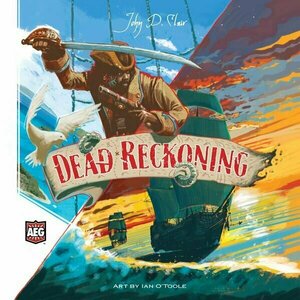
Dead Reckoning
Tabletop Game
Dead Reckoning is a game of exploration, piracy, and influence based in a Caribbean-esque setting....
